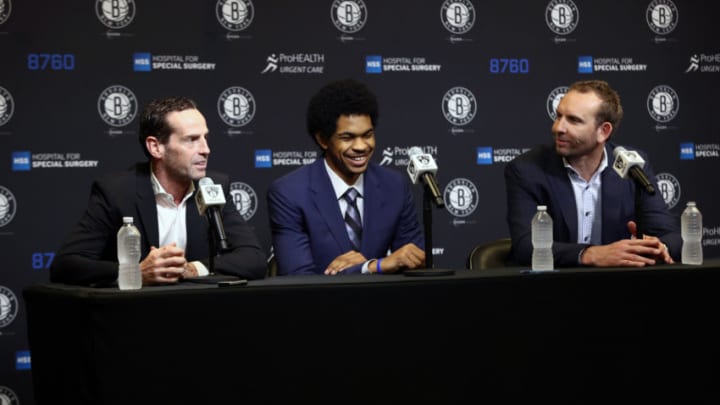Here’s a guide to the methodical and calculated way the Brooklyn Nets should go about the 2018 NBA Draft, in which they have multiple picks.
For what seems like the first time in eternity, the Brooklyn Nets have three selections in the upcoming NBA Draft. This is more than the per-team average amount of two, which is still a number the Nets have seldom reached recently without making draft-day trades.
Despite the moves of the past regime that threw away draft pick after draft pick, the new guys found a way to reacquire some. Not only have they accumulated picks, but they have also made the best of such selections. When they traded Thaddeus Young, they received a young malleable wing in Caris LeVert. When they traded Bojan Bogdanovic, they used the pick to choose a potential starting-caliber center in Jarrett Allen.
Even when they traded Tyler Zeller, a rotational center, they received what became the 45th overall pick in the 2018 draft. To say the least, this front office, spearheaded by general manager Sean Marks, knows how to squeeze the most value out of each possible maneuver.
Because of the franchise’s shrewdness in recent years, the team is in a surprisingly enviable position. Between the vast number of young and productive players on the roster, plus the solidarity of a few position groups, the Nets can go several different ways in the upcoming draft.
Lest we forget, the draft in general is a glorified crapshoot. After the first several elite-level selections, your guess is as good as mine in terms of who pans out. We have to remember that these players are human beings, and not all of them make the jump easily.
This is why franchises need as many shots in the dark as possible. Unless a team has an enviably high pick (which is mostly relegated to those in the single digits), the chances of striking on them are not too historically favorable.
More from Brooklyn Nets
- Why the new-look Brooklyn Nets are guaranteed to surprise
- NBA Trades: This Mavs-Nets deal may lead to Dallas adding a third star
- 5 NBA players everyone should be keeping a close eye on in 2023-24
- 5 NBA players facing do-or-die 2023–2024 seasons
- Is Mikal Bridges the Brooklyn Nets next star?
With picks at Nos. 29, 40 and 45, the Nets have three late shots at the crapshoot. Given the positions of these picks, they are extremely unlikely to pan out as elite players.
This is actually an advantage for Brooklyn. Why, you ask? Because of the optionality. Historically speaking, late first-rounders virtually commandeer second-round value. That is especially the case in this draft, as many draft sites opine; after the top 16-20 prospects, it’s a giant cluster of similarly valued role players.
The only difference between the two rounds is the contract; first round picks have guaranteed contracts, while second-rounders are typically non- or partially guaranteed. Arguably, that means the end of the first round is actually less team-friendly than the early second round.
This allows the Nets to stand pat with their picks. There is no need to trade up unless it is into that top group. Considering their position(s), that kind of trade is only possible if it is a salary dump in which the Nets take on a bad contract. That situation is possible, but only in very specific cases.
According to ESPN‘s Adrian Wojnarowski, the Denver Nuggets have made the No. 14 pick available in a Kenneth Faried trade in order to shave his salary:
@wojespn during the ESPN Mock Special just now:
— Ryan Blackburn (@NBABlackburn) May 30, 2018
"The Nuggets have been trying to get off of Kenneth Faried's contract for a year plus. They're a candidate to use that 14th pick to get off of that salary."
Lines up with what a lot of Nuggets pundits have thought for awhile.
Marks will most certainly look into this trade scenario, because salary has not been an issue in this rebuild. In the past, Marks has incurred several egregious salaries in order to get quality players at discounts. Examples include Allen Crabbe and DeMarre Carroll, both of which have had relative success in Brooklyn. (Though in this instance, Brooklyn would have to shed salary in order to make room for the last year of Faried’s contract.)
It’s a very unique way to rebuild, but a necessary one that the franchise has down to a science. Typical rebuilding and asset accumulation methods are out the window when a team lacks its own selections. If the Nets could purloin a lottery pick for taking on one year of Kenneth Faried, a combo big who could actually play significant minutes at a position of need, that’d be a steal and a half.
Paired with this idiosyncratic team-building method is a more typical strategy: Take as many shots as possible. Brooklyn has a ton of work to do with the current roster, and few (if any) incumbent players are solidified franchise cornerstones at this point.
Next: The 50 greatest NBA players of all time (updated, 2016-17)
This is even more reason for the Nets to stack the asset deck in their favor. Unless a salary dump situation comes along, which is actually somewhat likely in the new NBA cap climate of crunching money, it’s more advantageous to stick with what they have.
